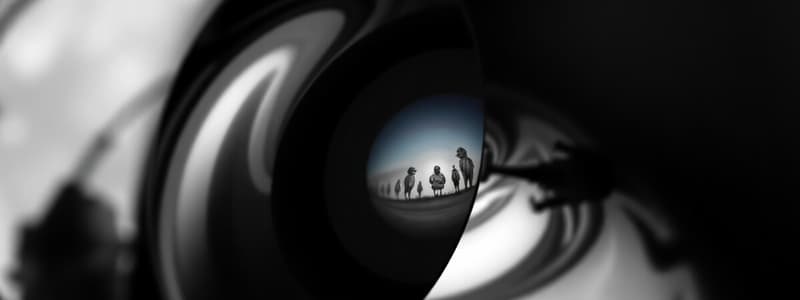Podcast
Questions and Answers
What happens to the image when the object is placed beyond the center of curvature (C) of a concave mirror?
What happens to the image when the object is placed beyond the center of curvature (C) of a concave mirror?
- The image is real, inverted, and bigger than the object.
- The image is real, inverted, and the same size as the object.
- The image is virtual and upright.
- The image is real, inverted, and smaller than the object. (correct)
At what location does an object need to be placed in order to form an image that is virtual and upright in a concave mirror?
At what location does an object need to be placed in order to form an image that is virtual and upright in a concave mirror?
- At the vertex (V)
- Between F and V (correct)
- At the focal point (F)
- At the center of curvature (C)
What characteristic of the image is formed when the object is placed very far away (at infinity) from a concave mirror?
What characteristic of the image is formed when the object is placed very far away (at infinity) from a concave mirror?
- The image is virtual, inverted, and the same size as the object.
- The image is real, inverted, and bigger than the object.
- The image is real, upright, and very large.
- The image is real, inverted, and very small (almost a point). (correct)
If an object is placed at the focal point (F) of a concave mirror, what is the outcome regarding the image?
If an object is placed at the focal point (F) of a concave mirror, what is the outcome regarding the image?
When the object is located at the center of curvature (C), what are the characteristics of the formed image?
When the object is located at the center of curvature (C), what are the characteristics of the formed image?
Flashcards are hidden until you start studying
Study Notes
Concave Mirror Image Formation
- Concave mirrors can form different types of images depending on the position of the object relative to the mirror.
- Object at infinity: Image formed at the focal point (F), real, inverted, and very small.
- Object beyond the center of curvature (C): Image formed between C and F, real, inverted, and smaller than the object.
- Object at C: Image formed at C, real, inverted, and the same size as the object.
- Object between C and F: Image formed beyond C, real, inverted, and larger than the object.
- Object at F: No image is formed because all reflected rays are parallel.
- Object between F and the vertex (V): Image formed behind the mirror, virtual, upright, and larger than the object.
Studying That Suits You
Use AI to generate personalized quizzes and flashcards to suit your learning preferences.




